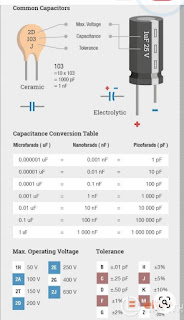All about Capacitors
What is Capacitor:-
Capacitor is a passive element which store electrostatic charge and used as a voltage controlling device, used in filter and to split phase in single phase induction motors. Capacitor opposes voltage change so it is called a voltage controlled device and used in charging circuit as Capacitor filter.
In starting when charge flow through it, it acts as a short circuit and when got fully charged acts as a open circuit.
XC= 1/2πfC
For low frequency capacitive reactance is very high and for high frequency capacitive reactance is very low so capacitor passes low frequencies and blocks high frequencies.
Types of Capacitor:-
- Electrolytic Capacitor:- These are high value of capacitors mosly available in microfarad range and used for voltage controlling near output and input to rugulate the voltage. These capacitors have polarity, positive point is connected with positive supply and negative point is connected with negative supply or neutral. These are available in aluminium and tantalum material in which tantalum is highly precise and costly.
- Ceramic Capacitor :- These are low value of capacitors available in picofarad range and used in filter circuits. These capacitors have no polarity.
- Paper Capacitor :- This type of capacitors are used for motor starter to split starting phase and in audio amplifier circuits. These capacitors are available from 300 picofarad to 4 milifarad in voltage range upto 600 volt.
- Polyester Capacitor :- This type of capacitors are used for high AC voltage controlling normally in trafomerless power supply circuits. These are available 50 V to 1500V range with capacitance range from 1nF to 15 microfarad. The tolerance of these capacitors is generally remains 5 %, 10 % and 20% range.
Some Important equations of Capacitor:-
1. Charging equation of Capacitor:-
Vt = VB (1- e^-t/RC)
It = I0 (-e^-t/RC)
2. Discharging equation of Capacitor:-
Vt = VB (e^-t/RC)
It = I0 (e^-t/RC)
Where RC= τ = Time constant
5τ is time to fully charge a Capacitor.
3. Series Combination of Capacitor:-
1/Ceq= 1/C1 + 1/C2 + 1/C3
Qeq= Q1 = Q2 = Q3
In series connected capacitors charge on each Capacitor remains same because in series same current flows through all capacitors and capacitors got charged through induction one by by one, inspite of different value of all capacitors
4. Parallel Combination of Capacitor:-
Ceq= C1 + C2 + C3
Qeq= Q1 + Q2 + Q3
In parallel connected capacitors Voltage across each capacitors remains the same that is why charge on each Capacitor differs and equivalent is the sum of charges on all capacitors connected in parallel.
Qeq= Ceq ×VB
Above figure shows colour coded Capacitor, color code value is similar to Resistor.
Second figure show practical image of a ceramic and electrolytic capacitor. In which ceramic Capacitor has coding on it and you can find out the value in picofarad with voltage rating.
In polyster capacitor code is written as 474J400V in which first three digit tells about capacitance in picofarad, J tells about tolerance and 400V is max operating voltage of Capacitor.
In polyster capacitor code is written as 474J400V in which first three digit tells about capacitance in picofarad, J tells about tolerance and 400V is max operating voltage of Capacitor.
Thank You






Post a Comment